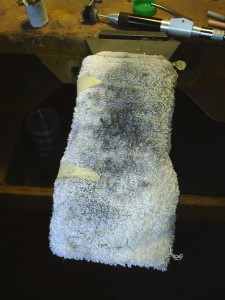Dealing with sterling silver jewelry shapes that are difficult to polish can be challenging.
Yesterday I was working on a large sterling silver jewelry project – a coronet for a friend who is a historic re-enactor. There are a LOT of differences between working on small pieces of jewelry, and working with something this large. And that reality prompted me to make a couple of quick tools to make the polishing safer and more effective. As I was working, I realized that a couple of the things that I had figured out might be of use to others, so here are two quick tips for polishing large objects.
The sterling silver jewelry piece that I was working on was challenging because it was large with lots of pointy bits that made it waay too dangerous to polish on a big polishing wheel. The opportunity for it to catch in the wheel and either do damage to me or the piece was a serious concern. So that meant it was time to haul out the flex shaft for finishing! But how to hold and polish the piece at the same time? The piece is essentially a large oval, made from a strip of sterling silver one inch wide and 25 inches long. The band is decorated with sterling silver annulets (think donut shapes) and a specialized form of a sterling silver cross with a pointy bottom and exaggerated pointy arms. The annulets are completely soldered flat to the band, but the crosses stick up above the top of the band with all of their pointy goodness just waiting to hook onto any polishing wheel that comes near them. I often polish smaller pieces by simply holding them in my hand, but that was NOT going to work for this large piece of sterling silver jewelry (well it’s more of an accessory than what we think of as jewelry). I am fortunate enough to have a jewelers’ bench in my Studio, so I put  the bench pin into the front of the bench. Now for those of you who don’t have something like a bench pin, well, I would probably lay a chair down on the floor on its side, sit on the floor or a stool, and use one of the legs as a support. The chair leg can serve the same function as a bench pin in this application.
the bench pin into the front of the bench. Now for those of you who don’t have something like a bench pin, well, I would probably lay a chair down on the floor on its side, sit on the floor or a stool, and use one of the legs as a support. The chair leg can serve the same function as a bench pin in this application.
I always have a pile of those white terry cloth shop towels in my Studio. They are inexpensive, and handy for everything from spills to padding, which is exactly what I used one for! I folded the towel in half, wrapped it around the bench pin and then held it in place with some masking tape. Now I had a clean, slightly rounded and padded, non-scratch support (a temporarily modified bench pin) that I could rest my massive sterling silver jewelry on for polishing. If I were using a chair leg, the towel would protect the chair and give the same kind of padding ( I would NOT do this with grandma’s valuable antique chair, just in case). The piece, remember it is a large oval, could literally hang on the towel-covered bench pin (or chair leg) and easily be held in place with one hand while I polished it with the other. There is another seriously important aspect to this arrangement. When it  was time to polish the tops of the sterling silver crosses, even the flexshaft wanted to hook onto and dance around the piece. Solution? Press the top of the crosses down into the towel just slightly. The polishing buff could easily do its job on the front of the crosses without catching the edge of the piece. It does get the towel dirty, but that is what those towels are for – they are called shop towels for a reason!
was time to polish the tops of the sterling silver crosses, even the flexshaft wanted to hook onto and dance around the piece. Solution? Press the top of the crosses down into the towel just slightly. The polishing buff could easily do its job on the front of the crosses without catching the edge of the piece. It does get the towel dirty, but that is what those towels are for – they are called shop towels for a reason!
My goal when I whipped up this quick little modified bench pin support was three-fold – protect me, protect the piece, and allow me to polish the piece until the sterling silver gleamed. Mission accomplished! I hope this gives you some ideas for making your own workshop safer and more productive! I’ve included a picture so you can see my “high-tech” support system and what the sterling silver piece looked like while it was being polished. Enjoy!

